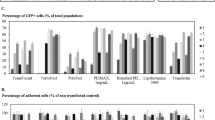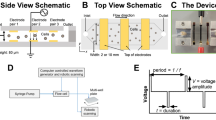Abstract
Lentiviruses are quite effective gene delivery systems for stable production of genetically engineered human cells. However, prior to using lentivirus to deliver genetic materials to cells of interest, the normal course of production of these lentiviruses involves a lengthy collection, purification, preservation, and quantification process. In this report, we demonstrate the ability for producer HEK293T cells to simultaneously produce lentiviral particles and transduce (i.e., infect) target cells through a membrane-based coculture system in a continuous, real-time mode which negates the need for a separate viral collection and quantification process. The coculture system was evaluated for major design features such as variations in HEK293T seeding density, target cell type densities, as well as membrane porosities to identify key relationships between lentiviral particle production rate and infection kinetics for adherent and suspension cell types. As a proof-of-concept for the creation of an engineered cell immunotherapy, we describe the ability to engineer human T cells isolated from PBMCs under the control of this coculture system in under 6 days with a GFP construct. These studies suggest the capability to combine and more closely automate the transfection/transduction process in order to facilitate well-timed and cost-effective transduction of target cell types. These experiments provide novel insight into the forthcoming transition into improved manufacturing systems for viral production and subsequent cell engineering.





Similar content being viewed by others
References
Aiuti A, Biasco L, Scaramuzza S, Ferrua F, Cicalese MP, Baricordi C et al (2013) Lentiviral hematopoietic stem cell gene therapy in patients with Wiskott-Aldrich syndrome. Science 341:1233151
Ausubel L, Hall C, Sharma A et al (2012) Production of CGMP-grade lentiviral vectors. Bioprocess Int 10:32–43
Bandeira V, Peixoto C, Rodrigues AF, Cruz PE, Alves PM, Coroadinha AS, Carrondo MJ (2012) Downstream processing of lentiviral vectors: releasing bottlenecks. Hum Gene Ther Methods 23:255–263
Biffi A, Montini E, Lorioli L, Cesani M, Fumagalli F, Plati T et al (2013) Lentiviral hematopoietic stem cell gene therapy benefits metachromatic leukodystrophy. Science 341:1233158
Cartier N, Hacein-Bey-Abina S, Bartholomae CC, Veres G, Schmidt M, Kutschera I et al (2009) Hematopoietic stem cell gene therapy with a lentiviral vector in X-linked adrenoleukodystrophy. Science 326:818–823
Cribbs A, Kennedy A, Gregory B, Brennan F (2013) Simplified production and concentration of lentiviral vectors to achieve high transduction in primary human T cells. BMC Biotechnol 13:98
Durand S, Cimarelli A (2011) The inside out of lentiviral vectors. Viruses 3:132–159
Farley DC, Iqball S, Smith JC, Miskin JE, Kingsman SM, Mitrophanous KA (2007) Factors that influence VSV-G pseudotyping and transduction efficiency of lentiviral vectors-in vitro and in vivo implications. J Gene Med 9:345–356
Gandara C, Affleck V, Stoll EA (2018) Manufacture of third-generation lentivirus for preclinical use, with process development considerations for translation to good manufacturing practice. Hum Gene Ther Methods 29:1–15
Geraerts M, Willems S, Baekelandt V, Debyser Z, Gijsbers R (2006) Comparision of lentiviral vector titration methods. BMC Biotechnol 6:34
Germeraad WT, Asami N, Fujimoto S, Mazda O, Katsura Y (1994) Efficient retrovirus-mediated gene transduction into murine hematopoietic stem cells and long-lasting expression using a transwell coculture system. Blood 84:780–788
Hacein-Bey-Abina S, Pai SY, Gaspar HB, Armant M, Berry CC, Blanche S, Bleesing J, Blondeau J, de Boer H, Buckland KF et al (2014) A modified gamma-retrovirus vector for X-linked severe combined immunodeficiency. N Engl J Med 371:1407–1417
Higashikawa F, Chang L (2001) Kinetic analyses of stability of simple and complex retroviral vectors. Virology 280:124–131
Kumru O, Wang Y, Gombotz C, Wayne R, Kelley-Clarke B et al (2018) Physical characterization and stabilization of a lentiviral vector against adsorption and freeze–thaw. Pharm Biotechnol 107:2764–2774
McCarron A, Donnelley M, McIntyre C, Parsons D (2016) Challenges of up-scaling lentivirus production and processing. J Biotechnol 240:23–30
Merten O, Wright JF (2016) Towards routine manufacturing of gene therapy drugs. Mol Ther Methods Clin Dev 3:16021
Merten O, Charrier S, Laroudie N et al (2010) Large-scale manufacture and characterization of a lentiviral vector produced for clinical ex vivo gene therapy application. Hum Gene Ther 22:343–356
Merten O, Hebben M, Bovolenta C (2016) Production of lentiviral vectors. Mol Ther Methods Clin Dev 3:16017
Milone M, O’Doherty U (2018) Clincal use of lentiviral vectors. Leukemia 32:1529–1541
Mukherjee S, Thrasher AJ (2013) Gene therapy for PIDs: progress, pitfalls and prospects. Gene 525:174–181
Nasri M, Karimi A, Farsani MA (2014) Production, purification and titration of a lentivirus-based vector for gene delivery purposes. Cytotechnology 66:1031–1038
Porter DL, Levine BL, Kalos M, Bagg A, June CH (2011) Chimeric antigen receptor-modified T cells in chronic lymphoid leukemia. N Engl J Med 365:725–733
Quintarelli C, Locatelli F, Caruana I, Angelis BD (2016) Overcoming challenges in CAR T-cell product CGMP release. Mol Ther 24:845–846
Rahman H, Taylor J, Clack B, Stewart RS, Canterberry SC (2013) Effects of storage conditions on the morphology and titer of lentiviral vectors. Faculty Publications. 94
Rogers GL, Herzog RW (2015) Gene therapy for hemophilia. Front Biosci 20:556–603
Rout-Pitt N, McCarron A, McIntyre C, Parsons D, Donnelley M (2018) Large-scale production of lentiviral vectors using multilayer cell factories. J Biol Methods 5:90
Segura MM, Kamen A, Garnier A (2006) Downstream processing of oncoretroviral and lentiviral gene therapy vectors. Biotechnol Adv 24:321–337
Sheu J, Beltzer J, Fury B, Wilczek K, Tobin S, Falconer D, Nolta J, Bauer G (2015) Large-scale production of lentiviral vector in a closed system hollow fiber bioreactor. Mol Ther Methods Clin Dev 2:15020
White M, Whittaker R, Gándara C, Stoll EA (2017) A guide to approaching regulatory considerations for lentiviral-mediated gene therapies. Hum Gene Ther Methods 28:163–176
Acknowledgements
This work was supported in part by the National Institutes of Health Grants (R01GM127353 and R01EB012521).
Author information
Authors and Affiliations
Contributions
LMT and BP formulated the research study design, LMT conducted experiments, acquired data, analyzed data, wrote manuscript. RP assisted in conducting experiments and acquiring data. MT assisted in conducting experiments.
Corresponding author
Additional information
Publisher's Note
Springer Nature remains neutral with regard to jurisdictional claims in published maps and institutional affiliations.
Electronic supplementary material
Below is the link to the electronic supplementary material.
Rights and permissions
About this article
Cite this article
Timmins, L.M., Patel, R.S., Teryek, M.S. et al. Real-time transfer of lentiviral particles by producer cells using an engineered coculture system. Cytotechnology 71, 1019–1031 (2019). https://doi.org/10.1007/s10616-019-00343-0
Received:
Accepted:
Published:
Issue Date:
DOI: https://doi.org/10.1007/s10616-019-00343-0




